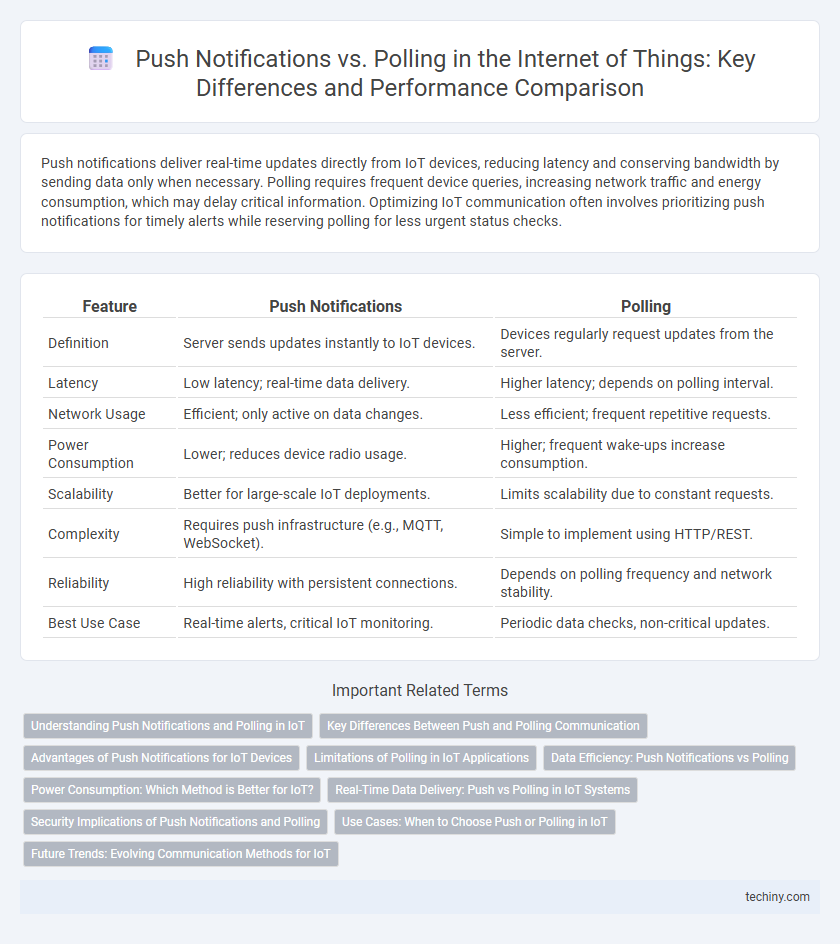Push notifications deliver real-time updates directly from IoT devices, reducing latency and conserving bandwidth by sending data only when necessary. Polling requires frequent device queries, increasing network traffic and energy consumption, which may delay critical information. Optimizing IoT communication often involves prioritizing push notifications for timely alerts while reserving polling for less urgent status checks.
Table of Comparison
| Feature | Push Notifications | Polling |
|---|---|---|
| Definition | Server sends updates instantly to IoT devices. | Devices regularly request updates from the server. |
| Latency | Low latency; real-time data delivery. | Higher latency; depends on polling interval. |
| Network Usage | Efficient; only active on data changes. | Less efficient; frequent repetitive requests. |
| Power Consumption | Lower; reduces device radio usage. | Higher; frequent wake-ups increase consumption. |
| Scalability | Better for large-scale IoT deployments. | Limits scalability due to constant requests. |
| Complexity | Requires push infrastructure (e.g., MQTT, WebSocket). | Simple to implement using HTTP/REST. |
| Reliability | High reliability with persistent connections. | Depends on polling frequency and network stability. |
| Best Use Case | Real-time alerts, critical IoT monitoring. | Periodic data checks, non-critical updates. |
Understanding Push Notifications and Polling in IoT
Push notifications in IoT enable real-time communication by allowing devices to receive immediate updates from a central server without constant checking, reducing bandwidth consumption and latency. Polling requires IoT devices to repeatedly request information at set intervals, increasing network traffic and power usage but offering simplicity in implementation for less time-sensitive applications. Understanding these methods helps optimize IoT system performance by balancing timely data delivery with resource efficiency.
Key Differences Between Push and Polling Communication
Push notifications deliver real-time updates by sending data directly from the server to IoT devices, minimizing latency and enhancing responsiveness. Polling requires IoT devices to repeatedly request data from the server at fixed intervals, which can lead to higher network traffic and delayed information delivery. Push reduces bandwidth consumption and power usage compared to polling, making it ideal for energy-constrained IoT environments.
Advantages of Push Notifications for IoT Devices
Push notifications offer real-time updates for IoT devices, significantly reducing latency compared to traditional polling methods. By eliminating constant device requests, they conserve battery life and optimize network bandwidth, enhancing overall device efficiency. This event-driven communication model supports timely alerts and immediate responses critical for smart home systems, healthcare monitoring, and industrial automation.
Limitations of Polling in IoT Applications
Polling in IoT applications often leads to increased latency and wasted bandwidth due to constant querying of devices regardless of data availability. This method consumes significant power, reducing battery life in resource-constrained IoT sensors and edge devices. Furthermore, polling struggles with real-time data requirements, limiting scalability and responsiveness in large IoT networks.
Data Efficiency: Push Notifications vs Polling
Push notifications enhance data efficiency by delivering real-time updates only when new information is available, minimizing unnecessary data transmission and network congestion in IoT devices. Polling continuously queries servers at fixed intervals, consuming more bandwidth and processing power even when no data changes occur. Optimizing IoT systems with push notifications reduces latency and energy consumption, critical factors for battery-operated sensors and devices.
Power Consumption: Which Method is Better for IoT?
Push notifications significantly reduce power consumption in IoT devices by allowing sensors to remain in low-power sleep mode until data transmission is necessary, whereas polling requires devices to frequently wake up and check for updates, leading to increased energy use. Studies show that push-based communication can extend battery life in IoT sensors by up to 70% compared to constant or periodic polling methods. Efficient power management through push notifications is essential for battery-operated IoT applications such as wearable health monitors and remote environmental sensors.
Real-Time Data Delivery: Push vs Polling in IoT Systems
Push notifications enable IoT devices to receive real-time data updates instantly by actively sending information when events occur, reducing latency and bandwidth consumption. Polling requires devices to repeatedly request data at intervals, causing delays and increased network traffic, which can hinder timely response in critical IoT applications. Efficient real-time data delivery in IoT systems depends heavily on push mechanisms to ensure prompt and scalable communication between sensors and cloud platforms.
Security Implications of Push Notifications and Polling
Push notifications in Internet of Things (IoT) environments enhance real-time communication but raise security concerns such as data interception and unauthorized access due to constant server-initiated connections. Polling, while less immediate, reduces exposure by limiting communication to client-requested intervals, lowering the risk of continuous attack surfaces. Implementing strong encryption protocols and authentication methods is crucial for both techniques to ensure data integrity and prevent malicious exploitation.
Use Cases: When to Choose Push or Polling in IoT
Push notifications in IoT are ideal for real-time alerts and device status updates, such as security alarms or environmental sensors, where immediate response is critical. Polling suits applications with predictable data retrieval intervals or when device resources are limited, like periodic meter readings or maintenance checks. Selecting between push and polling depends on latency requirements, network efficiency, and device power constraints.
Future Trends: Evolving Communication Methods for IoT
Push notifications enhance IoT communication by delivering real-time data with minimal latency and reduced power consumption compared to traditional polling methods. Future trends indicate a shift towards hybrid models integrating edge computing and AI-driven event detection to optimize notification relevance and network efficiency. Innovations in 5G and beyond will further enable scalable, low-latency push mechanisms critical for expansive IoT ecosystems.
Push Notifications vs Polling Infographic

 techiny.com
techiny.com